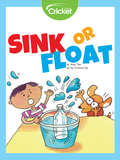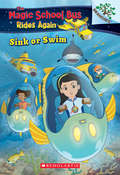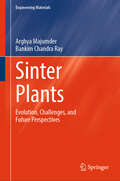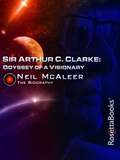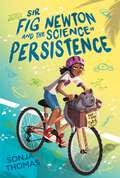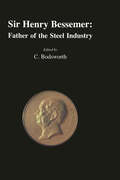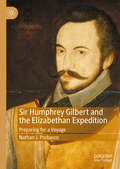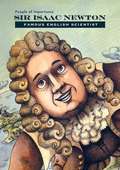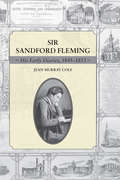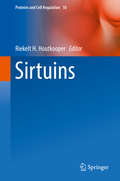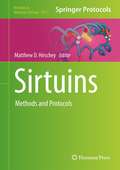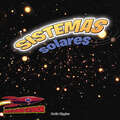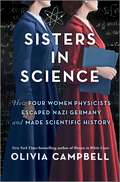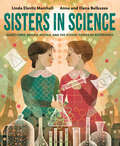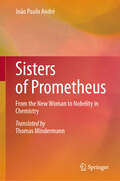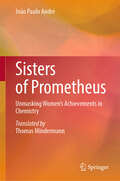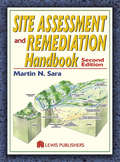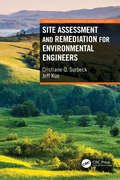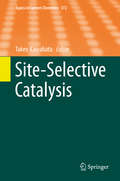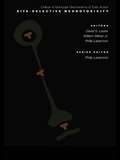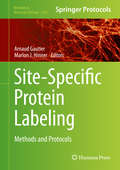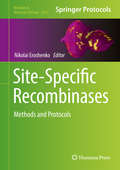- Table View
- List View
Sink or Float
by Amy TaoWill an orange float or sink in water? Are heavier objects able to float in water versus lighter objects? Learn about the density of materials and how water affects the objects! Make your own scientific discoveries and expand your knowledge by conducting your own experiments with water.
Sink or Swim: A Branches Book (The Magic School Bus Rides Again) (The Magic School Bus Rides Again #1)
by Judy KatschkeHop aboard--again! The Magic School Bus is back in a brand-new Netflix TV show.This series is part of Scholastic's early chapter book line called Branches, which is aimed at newly independent readers. With easy-to-read text, high-interest content, fast-paced plots, and illustrations on every page, these books will boost reading confidence and stamina. Branches books help readers grow!Seatbelts, everyone! The Magic School Bus is back and ready to ride again. Professor Frizzle's kid sister Fiona might be the new teacher at Walkerville Elementary, but she's got the same old motto: take chances, make mistakes, and get messy! When the class decides to go to Hawaii for their latest fieldtrip, they think they're in for rest, relaxation, and riding the waves. But when Wanda tries to save an endangered fish from a giant shark, its Wanda that needs saving. Luckily her own class learns something from a totally different type of school--fish!
Sino-African Cooperation for Schistosomiasis Control in Zanzibar: A Blueprint for Combating other Parasitic Diseases (Parasitology Research Monographs #15)
by Heinz Mehlhorn Kun YangOffering an example for transnational cooperation and successful reduction of a neglected tropical disease, this volume shows how Chinese scientists and local physicians controlled schistosomiasis in Zanzibar. Over a four-year study, local medical specialists and the population of Zanzibar were taught how to diagnose the parasitosis caused by flukes (trematode worms) of the genus Schistosoma. Furthermore, methods to eliminate the disease and prevent new infections were established. The developed control system will avoid repeated increase of human schistosomiasis, which is still prevalent in the tropics and subtropics. Rural populations and poor communities lacking access to clean drinking water and adequate sanitation are most affected. This book is a blueprint of activities urgently needed to combat schistosomiasis in countries with low medical impact. The strategies outlined are particularly relevant to parasitologists and professionals in public health, physicians, medical personnel and also governmental, healthcare and pharmaceutical institutions.
Sinter Plants: Evolution, Challenges, and Future Perspectives (Engineering Materials)
by Bankim Chandra Ray Arghya MajumderThis book provides a comprehensive examination of sintering technology and the crucial role it plays in the steelmaking process. The book begins with an introduction to the historical evolution of sintering, outlining its significance in modern steel production. Subsequent chapters delve into the fundamentals of sintering, raw materials and sinter mix composition, various sintering technologies, and optimization techniques for sinter plant operations. Environmental considerations, energy efficiency, and sustainability are thoroughly explored, alongside discussions on digitalization, automation, and quality assurance in sintering processes and its implications. The book also features case studies and industry examples from around the world, highlighting real-world challenges, innovative solutions, and best practices in sinter plant operations. Additionally, it provides insights into future trends and developments in sintering technology, offering a forward-looking perspective on the future of sinter plants and the steel industry as a whole. This book is an essential resource for engineers, researchers, and industry professionals seeking to deepen their understanding of sintering technology and navigate the complexities of modern steel production. With its comprehensive coverage, insightful analysis, and forward-looking perspective, the book emerges as a seminal work in the field of metallurgy.
Sir Arthur C. Clarke: A Biography
by Neil McaleerWith over 100 books in publication, Sir Arthur C. Clarke is one of the world's most renowned science fiction writers and winner of every award available in the genre-and this is the only complete biography of his life. This detailed and surprisingly intimate biography takes readers behind the scenes during Clarke's famous collaboration with Stanley Kubrick on the classic film 2001: A Space Odyssey. It also highlights the visionary scientific concepts he imagined in his books-many of which later became reality.This edition includes forewords by Ray Bradbury and Walter Cronkite as well as a special foreword for this first ebook edition by the author and is a substantial revision of the 1992 publication Arthur C. Clarke: The Authorized Biography, containing expanded material detailing the author's early life and last two decades. A unique chronicle of one of the founders of the science fiction genre, this is the most current and comprehensive biographical reference on the author, inventor, and futurist.
Sir Fig Newton and the Science of Persistence
by Sonja ThomasFrom the Desk of Zoe Washington meets Ways to Make Sunshine in this &“noteworthy&” (Kirkus Reviews, starred review) middle grade novel about a determined young girl who must rely on her ingenuity and scientific know-how to save her beloved cat.Twelve-year-old Mira&’s summer is looking pretty bleak. Her best friend Thomas just moved a billion and one miles away from Florida to Washington, DC. Her dad is job searching and he&’s been super down lately. Her phone screen cracked after a home science experiment gone wrong. And of all people who could have moved into Thomas&’s old house down the street, Mira gets stuck with Tamika Smith, her know-it-all nemesis who&’s kept Mira in second place at the school science fair four years running. Mira&’s beloved cat, Sir Fig Newton, has been the most stable thing in her life lately, but now he seems off, too. With her phone gone and no internet over the weekend at her strict Gran&’s house, Mira must research Fig&’s symptoms the old-fashioned way: at the library. She determines that he has &“the silent cat killer&” diabetes. A visit to the vet confirms her diagnosis, but that one appointment stretched family funds to the limit—they&’ll never be able to afford cat insulin shots. When Mira&’s parents tell her they may have to give Fig up to people who can afford his treatment, Mira insists she can earn the $2,000 needed within a month. Armed with ingenuity, determination, and one surprising ally, can Mira save her best (four-legged) friend before it&’s too late?
Sir Henry Bessemer: Father of the Steel Industry
by C. BodsworthThis volume, illustrated with many photographs and drawings, commemorates the centenary of the death of Sir Henry Bessemer, one of the outstanding inventors of the 19th century.
Sir Humphrey Gilbert and the Elizabethan Expedition: Preparing for a Voyage
by Nathan J. ProbascoThis book examines the 1583 voyage of Sir Humphrey Gilbert to North America. This was England's first attempt at colonization beyond the British Isles, yet it has not been subject to thorough scholarly analysis for more than 70 years. An exhaustive examination of the voyage reveals the complexity and preparedness of this and similar early modern colonizing expeditions. Prominent Elizabethans assisted Gilbert by researching and investing in his expedition: the Printing Revolution was critical to their plans, as Gilbert’s supporters traveled throughout England with promotional literature proving England’s claim to North America. Gilbert’s experts used maps and charts to publicize and navigate, while his pilots experimented with new navigating tools and practices. Though he failed to establish a settlement, Gilbert created a blueprint for later Stuart colonizers who achieved his vision of a British Empire in the Western Hemisphere. This book clarifies the role of cartography, natural science, and promotional literature in Elizabethan colonization and elucidates the preparation stages of early modern colonizing voyages.
Sir Isaac Newton: Famous English Scientist
by Anne Marie SullivanIsaac Newton's exploration of the world around him has shaped the direction of science for the last few hundred years. Newton's ideas about gravity, light, color, and the way things move have all shaped the way we think about the way the world works. Few people have been as important to science as Sir Isaac Newton. Learn about the story of one of the world's most influential scientific thinkers in Sir Isaac Newton: Famous English Scientist.
Sir Sandford Fleming: His Early Diaries, 1845-1853
by Jean Murray ColeSandford Fleming knew fame and many honours later in life, but the path was not always easy. His beginnings are revealed in these early diaries that record his thoughts as an eighteen-year-old leaving his family home in Scotland for Canada. After unsuccessful attempts to get work as a surveyor, he finally made important contacts in Toronto, and through involvement with the Mechanics’ Institute and the (Royal) Canadian Institute, became connected to the leading architects and engineers in the community. His work on major projects, including an ambitious plan for the Toronto Harbour and The Esplanade, ultimately led to his first big railway appointment in 1852. Best known for his role in mapping the Canadian Pacific Railway, he also designed Canada’s first adhesive postage stamp, the three-penny Beaver; was an early promoter of the Pacific cable; and is recognized around the world as the inventor of Standard Time. The recipient of many honours, Fleming was knighted by Queen Victoria in 1897.
Sirtuins
by Riekelt H. HoutkooperThe sirtuin family of proteins (SIRT1-7) received a lot of attention in recent years as they serve as metabolic sensors that control not only metabolism, but also aging and lifespan regulation. As such, sirtuins are strong targets for the treatment of age-related metabolic diseases, including obesity, diabetes, and cancer. Indeed, many research groups as well as pharmaceutical companies discovered food components and/or drugs that target the sirtuins and provide significant health benefits. This book focuses on various aspects of sirtuin biology, from basic biochemistry, via molecular function, to its role in (fighting) human disease.
Sirtuins: Methods and Protocols
by Matthew D. HirscheyFeaturing a diverse array of model organisms and scientific techniques, Sirtuins: Methods and Protocols collects detailed contributions from experts in the field addressing this vital family of genes. Opening with methods to generate sirtuin biology tools, the book continues by covering methods to identify sirtuin substrates, to measure sirtuin activity, and to study sirtuin biology. Written in the highly successful Methods in Molecular Biology series format, chapters include introductions to their respective topics, lists of the necessary materials and reagents, step-by-step, readily reproducible laboratory protocols, and tips on troubleshooting and avoiding known pitfalls. Comprehensive and easy to use, Sirtuins: Methods and Protocols presents detailed protocols for sirtuin research that can be followed directly or modified to investigate new areas of sirtuin biology.
Sistemas solares: Solar Systems: Planets, Stars, and Orbits (Inside Outer Space)
by Nadia HigginsOur closest solar system is about 10 light years away.It has two main types of planets. Some are rocky and small, like planet Earth, while others are huge balls of gas, like Jupiter. Learn about how astronomers once thought our solar system was the one and only, to how they have now discovered hundreds of stars with planets orbiting them, which means there could be billions of solar systems in outer space! Just maybe, these alien worlds could host life, like our own amazing planet. This book allows students to use observations of the Sun, moon, and stars to describe patterns that can be predicted.
Sisters in Science: How Four Women Physicists Escaped Nazi Germany and Made Scientific History
by Olivia CampbellThe extraordinary true story of four women pioneers in physics during World War II and their daring escape out of Nazi Germany In the 1930s, Germany was a hotbed of scientific thought. But after the Nazis took power, Jewish and female citizens were forced out of their academic positions. Hedwig Kohn, Lise Meitner, Hertha Sponer and Hildegard Stücklen were eminent in their fields, but they had no choice but to flee due to their Jewish ancestry or anti-Nazi sentiments. Their harrowing journey out of Germany became a life-and-death situation that required Herculean efforts of friends and other prominent scientists. Lise fled to Sweden, where she made a groundbreaking discovery in nuclear physics, and the others fled to the United States, where they brought advanced physics to American universities. No matter their destination, each woman revolutionized the field of physics when all odds were stacked against them, galvanizing young women to do the same. Well researched and written with cinematic prose, Sisters in Science brings these trailblazing women to life and shows us how sisterhood and scientific curiosity can transcend borders and persist—flourish, even—in the face of seemingly insurmountable odds.
Sisters in Science: Marie Curie, Bronia Dluska, and the Atomic Power of Sisterhood
by Linda Elovitz MarshallDiscover the fascinating true story of Nobel Prize winner Marie Curie and her sister Bronia, two trailblazing women who worked together and made a legendary impact on chemistry and health care as we know it.Marie Curie has long been a well-known name around the world. Though Marie made extraordinary scientific advances discovering new elements with her husband, Pierre, many students do not know about the powerful bond that propelled her into science: her sisterhood with Bronia! A force in academia and health care herself, Bronia made significant contributions to the scientific world, along with her loving support of sister Marie. Sisters in Science is a compelling biography of two sisters who created their own paths while keeping the atomic bonds of sisterhood strong.
Sisters of Prometheus: From the New Woman to Nobelity in Chemistry
by João Paulo AndréThis comprehensive book portrays the long-overdue recognition of women's work in chemistry, which only materialized with their late access to universities. Besides describing their scientific triumphs, it unveils the human side of the characters involved, providing an intimate perspective, often supported by extracts from their correspondence. By delving into their personal stories, struggles, and successes, this book brings these women to life. Written with simplicity and rigor, it aims to inspire and educate readers of all backgrounds about the extraordinary scientific achievements of these trailblazing women.
Sisters of Prometheus: Unmasking Women's Achievements in Chemistry
by João Paulo AndréThis monograph explores the participation of women in alchemy, chemical crafts, and the early stages of modern chemistry. By contextualizing their achievements within the broader social, cultural, and scientific landscapes of their time, this book enables readers to seize the challenges these women confronted and the obstacles they triumphed over. Alongside narrating how they shaped the development of chemistry, including their contributions to the body of chemical literature, it also emphasizes pivotal moments and milestones in the history of women's emancipation. The book's comprehensive and integrative approach, complemented by engaging storytelling, renders it an indispensable resource for students, researchers, and general readers alike.
Site Assessment and Remediation Handbook
by Martin N. SaraCompletely revised and updated, the Second Edition of Site Assessment and Remediation Handbook provides coverage of new procedures and technologies for an expanded range of site investigations. With over 700 figures, tables, and flow charts, the handbook is a comprehensive resource for engineers, geologists, and hydrologists conducting site investi
Site Assessment and Remediation for Environmental Engineers (Fundamentals of Environmental Engineering)
by Cristiane Q. Surbeck Jeff KuoThis book serves as a primary textbook for environmental site investigation and remediation of subsurface soil and groundwater. It introduces concepts and principles of field investigative techniques to adequately determine the extent of contamination in the subsurface for the selection of cleanup alternatives. It then focuses on practical calculations and skills needed to design and operate remediation systems that will both educate students and be useful for entry-level professionals in the field.Features:• Examines the practical aspects of investigating and cleaning up contaminated soil and groundwater• Contains scenarios, illustrations, equations, and example problems with discussions that illustrate various practical situations and interpret the results• Includes end-of-chapter problems to reinforce student learning• Provides a regulatory and risk analysis context, as well as public and community involvement aspects• Discusses sustainability and performance assessment of the remediation methods presentedSite Assessment and Remediation for Environmental Engineers provides upper-level undergraduate and graduate students with practical, project-oriented knowledge of how to investigate and clean up a site contaminated with chemicals and hazardous waste.
Site-Selective Catalysis
by Takeo KawabataThe series Topics in Current Chemistry presents critical reviews of the present and future trends in modern chemical research. The scope of coverage is all areas of chemical science including the interfaces with related disciplines such as biology, medicine and materials science. The goal of each thematic volume is to give the non-specialist reader, whether in academia or industry, a comprehensive insight into an area where new research is emerging which is of interest to a larger scientific audience. Each review within the volume critically surveys one aspect of that topic and places it within the context of the volume as a whole. The most significant developments of the last 5 to 10 years are presented using selected examples to illustrate the principles discussed. The coverage is not intended to be an exhaustive summary of the field or include large quantities of data, but should rather be conceptual, concentrating on the methodological thinking that will allow the non-specialist reader to understand the information presented. Contributions also offer an outlook on potential future developments in the field. Review articles for the individual volumes are invited by the volume editors. Readership: research chemists at universities or in industry, graduate students
Site-Selective Neurotoxicity
by William Slikker Jr. Philip Lazarovici David S. LesterThis unique volume provides interdisciplinary coverage of the mechanistic perspective of neurotoxicity that focuses on the site of action of known neurotoxins. It provides the reader with an insight into the common characteristics of neurotoxin action on the nervous system and examines sites of action at three levels of complexity: molecular, cellu
Site-Specific Protein Labeling
by Arnaud Gautier Marlon J. HinnerThis detailed volume provides in-depth protocols for protein labeling techniques and applications, with an additional focus on general background information on the design and generation of the organic molecules used for the labeling step. Chapters provide protocols for labeling techniques and applications, with an additional focus on general background information on the design and generation of the organic molecules used for the labeling step. Written in the highly successful Methods in Molecular Biology series format, chapters include introductions to their respective topics, lists of the necessary materials and reagents, step-by-step, readily reproducible laboratory protocols, and tips on troubleshooting and avoiding known pitfalls. Authoritative and practical, Site-Specific Protein Labeling: Methods and Protocols provides a comprehensive overview on the most relevant and established labeling methodologies, and helps researchers to choose the most appropriate labeling method for their biological question.
Site-Specific Recombinases
by Nikolai EroshenkoThis books aims to provide an up-to-date guide to using recombinases in the laboratory. Chapters guide the reader through construction of transgenic animals, recombinase-mediated cassette exchange (RMCE), spatial control of recombinase expression and in vivo delivery approaches, immunohistochemistry and fluorescence-based phenotyping methods, biochemical methods, and recombinase-based production of minimal DNA vectors. Written in the highly successful Methods in Molecular Biology series format, chapters include introductions to their respective topics, lists of the necessary materials and reagents, step-by-step, readily reproducible laboratory protocols, and tips on troubleshooting and avoiding known pitfalls. Authoritative and cutting-edge, Site-Specific Recombinases: Methods and Protocols aims to serve as a valuable resource for working with recombinases, and inspires further creativity in the field.
Site-directed insertion of transgenes
by Philippe Duchateau Sylvaine RenaultThe post-genomic era has brought new challenges and opportunities in all fields of the biology. In this context, several genome engineering technologies have emerged that will help deciphering genes function by as well as improve gene therapy strategies. Genomic modifications such as knock-in, knock-out, knock-down, sequence replacement or modification can today be routinely performed. However, in front of this large palette of methodologies scientists may experience difficulties to gather useful information's scattered within the literature. This book aims to present the state of this field from basic mechanisms of site-directed modifications to their applications in a wide range of organisms such as bacteria, yeast, plants, insects, mammals. It will discuss the problems encountered when using the random integration strategy and present the recent advances made in targeted genome modification. Technologies based on Zinc Finger nucleases, Meganucleases, TALEN, CRE and FLP recombinase, C31 integrase, transposases and resolvases are fully detailed with their strengths and weaknesses. All these information's will help students and experienced researchers to understand and choose the best technology for their own purposes.
